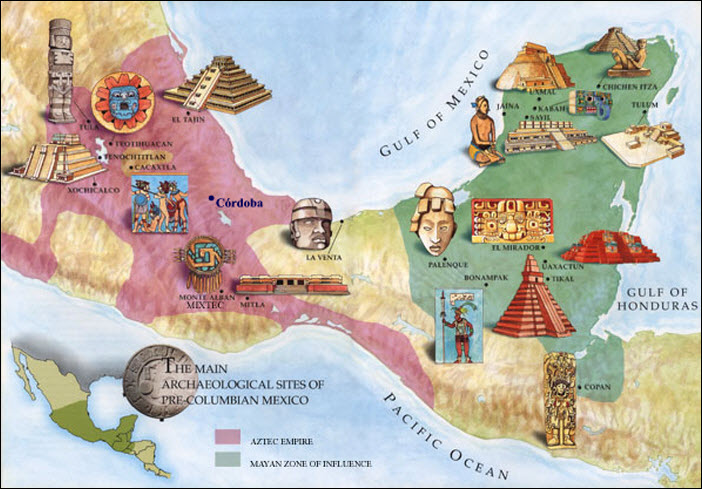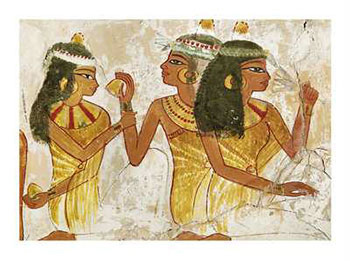- You have an assignment due today -- keep an eye on the assignment page.
- have a little review of the Mayan math,
- then find out how those Egyptians were doing math.

- What did we discover from this Mayan lunar calendar?

"The Maya also made their own very accurate measurement of the solar year, putting it at 365.242 days. The latest computations give us the figure of 365.242198: so the Maya were actually far nearer the true figure than the current Western calendar of 365 days (which, with leap years, gives a true average of 365.2425)." From The Universal History of Numbers, by George Ifrah.
- How would the Mayans write the number we call 1729?
- I'll write something in Mayan, and you tell me what it is in our number system.
- What distinguishes the Mayans from the Babylonians? Well zero for one thing. The Mayans had one!
- Let's do a few examples with Mayan numbers: write
- 37 in Mayan
- 694 in Mayan
- 1034 in Mayan

- How does the game work?
- Can you win at the game? You should be able to do it every time!
- Each of you will be part of a team of three, taking turns playing the roles of contestent, Fraudini, and someone to check the play.
- Here's the handout for the cards, if you want to print off another copy.
(I underline "distinct" because you cannot repeat powers: otherwise you could write, for example,
| 1 | 321 | |
| 2 | ||
| 4 | ||
| 8 | ||
| 16 | ||
| 32 | ||
| 64 | ||
| 128 | Too big! |
Now add up those rows marked with an asterix (*), and you'll get the answer (35952).
- 43*16
- 21*79
- fractions -- binary decimals, oh Ra!
- First of all, division is just multiplication backwards, right?
Let's look at the simplest example imaginable: divide 32 by 8. We can actually do it by Egyptian multiplication, since 8 divides into 32 evenly:
1 8 2 16 4 32 * So the answer is 4 (how do we get 4?)
- Similarly we could divide 40 by 8, using the same
table (again easy, since 8 divides into 40 evenly):
1 8 * 2 16 4 32 * So the answer is 5 (how do we get 5?)
- When the denominator doesn't divide the numerator
evenly, fractions make it more interesting:
Let's look at an example: divide 35 by 8.
In a way we turn it into a multiplication problem: what times 8 equals 35? So we know the 8, and use it to "double" -- but then to "halve", when 8 won't go evenly into 35:
1 8 2 16 4 32 * 1/2 4 1/4 2 * 1/8 1 * So the answer is 4+1/4+1/8
(Where have we seen those fractions before? Look to the Eye of Horus!)
- the Egyptians restricted
themselves to the so-called "unit fractions", which are
fractions of the form 1/m:
unit
fraction table, which is found on the Rhind
Papyrus (which dates to around 1650 BCE).
But they didn't restrict themselves to "halving", as our next example shows. Divide 6 by 7:
1 7 1/2 3+1/2 * 1/4 1+1/2+1/4 * 1/7 1 1/14 1/2 * 1/28 1/4 * So the answer is 1/2+1/4+1/14+1/28
- Why did
Egyptians do things this way? (an example division problem, using binary)
Dominic Olivastro, "Ancient Puzzles", suggests a third reason why this use of unary fractions is good. Consider the problem Ahmes poses of dividing 3 loaves of bread between 5 people. We would answer "each person gets 3/5-ths of a loaf". If we implemented our solution, we might then cut 2 loaves into 3/5 | 2/5 pieces, with bread for 3 people; then cut one of the smaller pieces in half, giving the other two people 2/5 + 1/5 pieces. Mathematically acceptable, but try this with kids and they will insist that it is not an even division. Some have larger pieces, some have smaller. Ahmes would calculate 3/5 as : 3/5 = ()3 + ()5 + ()15 [ = 1/3 + 1/5 + 1/15 ] Now cut one loaf into fifths, cut two more into thirds, then take one of the 1/3-rd pieces and cut it into 5-ths (for the 1/15-th pieces), and you can now distribute everyone's 3/5-ths share in a way that _looks_ equal, since they will have exactly the same size pieces. (And no, I don't want to argue about the crust.)
- Here's a relatively easy one: Suppose Fatima had 3
loaves to share between 4 people. How would she do it?
(Think about what the answer means, in terms of bread.)
- A little trickier:
- How would you divide 5 by 7?
- How can we use the unit fraction table to get the same answer?
- How would you like to do story problems like this one?!